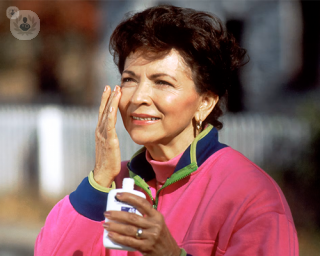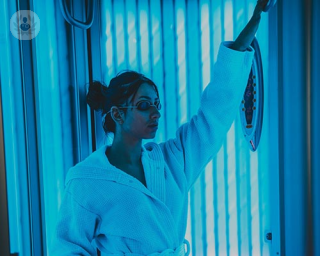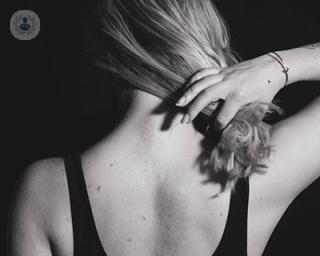Sun damage
Dr Sheru George - Dermatology
Created on: 04-03-2020
Updated on: 04-26-2023
Edited by: Conor Dunworth
What is sun damage?
Years of sun exposure can have a profound effect on our skin, eventually leading to sun damage. Although it can feel good to be in the sun, too much exposure to ultraviolet (UV) rays can cause skin ageing and wrinkles, dark spots, thickened skin, skin cancer and other skin changes.

What kind of damage can the sun do to the skin?
Too much sun exposure can cause some of the following skin problems:
- Sunburn
Sunburn is essentially injury to the skin that appears immediately after the skin is exposed to UV radiation. Almost everyone has or will experience a mild sunburn in their lifetimes and results in a pink or red, painful area of the skin. In more severe cases, it can cause small tiny fluid-filled bumps or blisters.
- Dry, rough skin
The sun can leave you with dry, rough skin. Over time, your skin becomes less moist and stops producing its essential oils. This can happen at any age, even in young people.
- Wrinkles and aged-skin
Elastosis is the destruction of the elastic and collagen tissue. This condition can occur in people who spend a lot of time in the sun. If it happens, your skin texture will change and result in wrinkles. Some areas may thicken causing deep wrinkles, especially on the back of the neck. In other parts, your skin may become thinner causing finer wrinkles, bruising and skin tearing. Wrinkles typically appear in areas that are exposed to the sun the most such as the chest, arms, hands and face.
- Bruising
Sometimes, the blood vessels can be damaged from the sun causing easy bruising, and as your skin gets thinner, it can reveal tiny blood vessels under the skin - a condition known as telangiectasias. This commonly occurs on the face.
- Skin colour changes
The pigment in your skin gets temporarily darker when exposed to the sun, however, long-lasting colour change can occur too. Hyperpigmentation is a common and often harmless condition where areas of the skin become darker, caused by excess melanin production. Another common condition is called solar lentigos, which presents as small brown spots on the skin. Again, they are usually harmless and seen mostly in people over the age of 40. Additionally, more freckles can appear in light-skinned people on the chest, arms, upper back and hands.
There is also a condition called sallowness where the skin loses its natural complexion and turns a deep yellow. Other times, in very fair people, guttate hypomelanosis can form which consists of small white spots on the legs, hands and arms.
- New moles
Although it is normal to acquire new moles from time to time, it is thought that the sun can stimulate their formation. Moles are generally concentrations of pigment-producing cells (melanocytes) in your skin and most are benign; however, new moles in adults are more likely to become cancerous (melanoma).
- Pre-cancerous skin changes
Actinic keratosis is a rough, scaly patch on your skin usually on your lips, ears, back of your hands, scalp, neck and forearms. This condition can give rise to skin cancers such as squamous cell carcinomas.
- Skin cancer
Ultraviolet radiation from the sun is the biggest cause of skin cancer. The three main types are basal cell carcinoma, squamous cell carcinoma and melanoma - the latter being the most serious.
How can sun damage be prevented?
Staying out of the sun between 10 am and 3 pm during the summer is the best prevention. This is when the sun is at its highest peak and its rays are the strongest.
If you are in the sun, you should always wear suncream and suitable clothing to cover your body. This also includes a hat to protect your face and sunglasses to protect your eyes.

The British Association of Dermatologists recommends that wearing suncream with an SPF of over 30 provides a good standard of protection, as long as it is paired with protective clothing and adequate periods spent in the shade.
Who is at risk of sun damage?
Everyone is at risk of sun damage but some people need to take more care when spending time in the sun. These are people who have:
- fair skin and light coloured hair
- lots of freckles or moles
- a history of sunburn
- skin that burns easily
- family history of skin cancer
Those who have dark brown or black skin burn slightly less in the sun and have a lower risk of sun damage, however, they should still follow precautions to protect themselves.
How is sun damage diagnosed?
Most of the time, a doctor can diagnose sun damage from simply examining your skin. Occasionally, a biopsy is done to rule out cancer which involves removing a small piece of damaged skin and sending it to a laboratory for testing.
Can sun damage be treated?
The treatment depends on the form of sun damage:
- Dry skin - You can treat this yourself by applying moisturiser regularly and staying out of the sun. Avoid hot showers and baths as this might irritate the skin more and use unscented soaps.
- Sunburn - You should apply aftersun cream which you can buy at any pharmacy and most supermarkets. In addition, try applying a cool compress or spray the area with cool water, and if discomfort persists, you can take anti-inflammatory medication. If you have a severe and extensive sunburn, you should see your doctor who will prescribe stronger medications.
- Wrinkles and skin colour changes - This is more difficult to reverse, and a lot of the times it is not possible to treat this. Some doctors may try prescribing tretinoin (vitamin A) cream to apply to the skin, others may offer chemical peels, laser resurfacing or dermabrasion. Botox fillers can temporarily improve the appearance of wrinkles and give the skin a more youthful look.
- Actinic keratosis - Many topical creams can treat this and help reduce your chances of developing skin cancer. Other treatments include cryotherapy, chemical peels, laser resurfacing and photodynamic treatment. Because actinic keratosis is a sign that you may be at an increased risk of skin cancer, your doctor should schedule regular follow-up examinations to check this.
- Skin cancer - It depends on your circumstance but surgery is usually the main treatment for non-melanoma skin cancer. Other treatments include cryotherapy, anti-cancer creams, photodynamic therapy, radiotherapy and electrochemotherapy. In the case of melanoma, your treatment will likely be a combination of surgery, radiotherapy and chemotherapy. You will also need to be tested to see if cancer has spread to other parts of the body. If it has, then further treatment will be needed. In advance staged melanoma, immunotherapy may be offered as part of a clinical trial.
Which kind of specialist treats sun damage?
The type of specialist that treats sun-damaged skin is typically a dermatologist.








